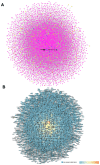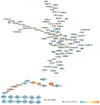The Identification of New Pharmacological Targets for the Treatment of Glaucoma: A Network Pharmacology Approach
- PMID: 39458974
- PMCID: PMC11509888
- DOI: 10.3390/ph17101333
The Identification of New Pharmacological Targets for the Treatment of Glaucoma: A Network Pharmacology Approach
Abstract
Background: Glaucoma is a progressive optic neuropathy characterized by the neurodegeneration and death of retinal ganglion cells (RGCs), leading to blindness. Current glaucoma interventions reduce intraocular pressure but do not address retinal neurodegeneration. In this effort, to identify new pharmacological targets for glaucoma management, we employed a network pharmacology approach. Methods: We first retrieved transcriptomic data from GEO, an NCBI database, and carried out GEO2R (an interactive web tool aimed at comparing two or more groups of samples in a GEO dataset). The GEO2R statistical analysis aimed at identifying the top differentially expressed genes (DEGs) and used these as input of STRING (Search Tool for the Retrieval of Interacting Genes/Proteins) app within Cytoscape software, which builds networks of proteins starting from input DEGs. Analyses of centrality metrics using Cytoscape were carried out to identify nodes (genes or proteins) involved in network stability. We also employed the web-server software MIRNET 2.0 to build miRNA-target interaction networks for a re-analysis of the GSE105269 dataset, which reports analyses of microRNA expressions. Results: The pharmacological targets, identified in silico through analyses of the centrality metrics carried out with Cytoscape, were rescored based on correlations with entries in the PubMed and clinicaltrials.gov databases. When there was no match (82 out of 135 identified central nodes, in 8 analyzed networks), targets were considered "potential innovative" targets for the treatment of glaucoma, after further validation studies. Conclusions: Several druggable targets, such as GPCRs (e.g., 5-hydroxytryptamine 5A (5-HT5A) and adenosine A2B receptors) and enzymes (e.g., lactate dehydrogenase A or monoamine oxidase B), were found to be rescored as "potential innovative" pharmacological targets for glaucoma treatment.
Keywords: computational systems biology; glaucoma; network pharmacology; neuroinflammation; pharmacological targets.
Conflict of interest statement
The authors declare that this research was conducted in the absence of any commercial or financial relationships that could be construed as a potential conflict of interest.
Figures









Similar articles
-
Construction of miRNA-mRNA regulatory network indicates potential biomarkers for primary open-angle glaucoma.BMC Med Genomics. 2023 Nov 8;16(1):280. doi: 10.1186/s12920-023-01698-2. BMC Med Genomics. 2023. PMID: 37940950 Free PMC article.
-
[Aiming for zero blindness].Nippon Ganka Gakkai Zasshi. 2015 Mar;119(3):168-93; discussion 194. Nippon Ganka Gakkai Zasshi. 2015. PMID: 25854109 Review. Japanese.
-
Integrated Bioinformatics-Based Identification and Validation of Neuroinflammation-Related Hub Genes in Primary Open-Angle Glaucoma.Int J Mol Sci. 2024 Jul 26;25(15):8193. doi: 10.3390/ijms25158193. Int J Mol Sci. 2024. PMID: 39125762 Free PMC article.
-
Research on the Regulatory Mechanism of Ginseng on the Tumor Microenvironment of Colorectal Cancer based on Network Pharmacology and Bioinformatics Validation.Curr Comput Aided Drug Des. 2024;20(5):486-500. doi: 10.2174/1573409919666230607103721. Curr Comput Aided Drug Des. 2024. PMID: 37287284
-
Differential Retinal Ganglion Cell Vulnerability, A Critical Clue for the Identification of Neuroprotective Genes in Glaucoma.Front Ophthalmol (Lausanne). 2022 May 31;2:905352. doi: 10.3389/fopht.2022.905352. eCollection 2022. Front Ophthalmol (Lausanne). 2022. PMID: 38983528 Free PMC article. Review.
Cited by
-
Age-Related Dysregulation of α5β1 and αvβ3 Integrin Activity Alters Contractile Properties of Trabecular Meshwork Cells.Invest Ophthalmol Vis Sci. 2025 Jun 2;66(6):31. doi: 10.1167/iovs.66.6.31. Invest Ophthalmol Vis Sci. 2025. PMID: 40488712 Free PMC article.
References
-
- GBD 2019 Blindness and Vision Impairment Collaborators. Vision Loss Expert Group of the Global Burden of Disease Study Causes of blindness and vision impairment in 2020 and trends over 30 years, and prevalence of avoidable blindness in relation to VISION 2020: The Right to Sight: An analysis for the Global Burden of Disease Study. Lancet Glob. Health. 2021;9:e144–e160. doi: 10.1016/S2214-109X(20)30489-7. - DOI - PMC - PubMed
Grants and funding
LinkOut - more resources
Full Text Sources

